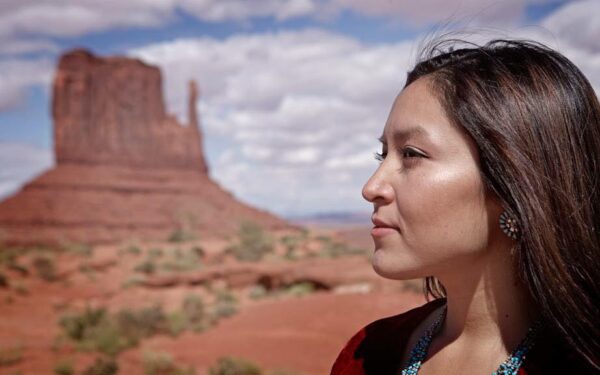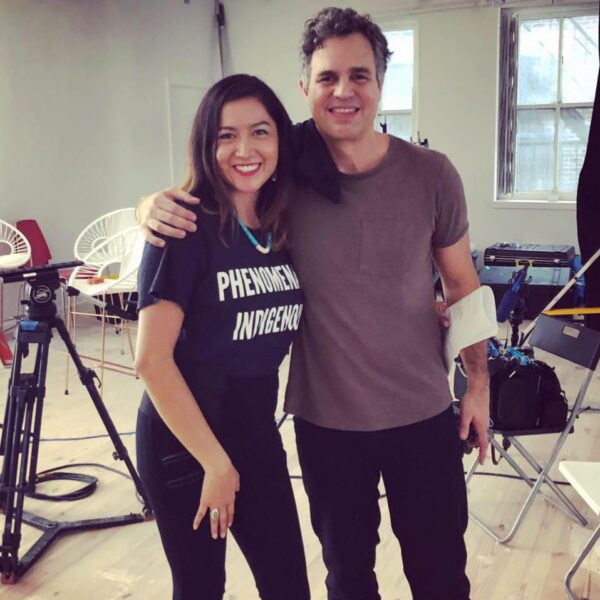
- Details
- By Rich Tupica
Editor's Note: This Q&A is part of a new series of profiles spotlighting both established Native American business owners, entertainers and emerging entrepreneurs who are working through the pandemic. Native News Online shares their story, including how they became the person they are today and how they’re coping with the COVID-19 crisis.
KIRTLAND, New Mexico — Activist Allie Young was living in Los Angeles two months ago, working in the entertainment business, when she felt the call to return to her hometown of Kirtland, New Mexico as the coronavirus began to spread.
Young, 30, is a citizen of the Diné (Navajo) Nation, which has been one of the hardest hit regions nationally by COVID-19, the disease caused by coronavirus. Young is a natural-born storyteller who’s currently pitching big film/television projects to major networks. When she’s not working in the entertainment industry, she’s keeping busy with activism work.
In the two months since she's been home, Young has leaned into her talents to launch a pair of nationally publicized movements to protect Navajo elders and culture by supporting front-line efforts to combat COVID-19 on the Nation. The Protect the Sacred and #NavajoStrong projects are recruiting volunteers and raising awareness and funds with the help of entertainers like her friend, the actor Mark Ruffalo, as well as other Hollywood A-Listers like Paul Rudd, Ellen DeGeneres, Mark Hamill and Taika Waititi, to only name a few.
Prior to all of these initiatives, her daily mission was to stay focused on her objective of ensuring the stories of her people are no longer filtered through the fabricated American narrative perpetuated in textbooks and Hollywood Westerns. Her goal? To make the stories authentic and from the original peoples — the original storytellers. While back home in New Mexico, Young continues networking virtually, but also reconnecting with her roots. She was raised by her mother Joan Carlston and father Frank Young II, who are both Navajo and were raised in Arizona. “This region of the Navajo Nation, which is currently the most coronavirus infected area on Navajo, is where I spent a lot of my childhood summers going to rez rodeos with my family,” Young told Native News Online. “I come from a long line of bull riders and Indian cowboys. My dad rode in the Indian National Finals Rodeo and my brothers and uncles rode in professional bull riding circuits. I was a young rez cowgirl myself growing up. ” Aside from rodeos, Young spent many days attending traditional ceremonies and also playing outside under the stars alongside her three siblings, including a younger brother who committed suicide in 2008 at 17-years old. With his birthday being May 27, her late brother has been on her mind even more this month. “He is the reason I am committed to the Native youth work that I do,” Young said. “I do it in memory of him … Those childhood memories are so vivid in my mind and heart, and make me long for the simple and adventurous days with my baby brother,” she added. “There isn’t a day that goes by that I don’t think of him and do my work for him. “These beautiful, and also traumatic, experiences shaped me and made me the person I am today,” she added. “I am rooted in my Diné ceremonies and culture, in Hózhó — the Beautyway — and it’s made me the proud Diné woman I am. It has also given me the strength to stand in the power and resilience of my ancestors.”
 Allie Young with Hollywood star Mark Ruffalo, a vocal supporter of Protect the Sacred and #NavajoStrong. (courtesy photo)
Allie Young with Hollywood star Mark Ruffalo, a vocal supporter of Protect the Sacred and #NavajoStrong. (courtesy photo)
To learn more about Young, and how she’s keeping busy with activism during the pandemic, read the Native News Online Q&A. (This interview has been edited and condensed for clarity.)
Things have changed so much over the last couple months. What were you up to just prior to the COVID-19 outbreak, which sparked the launch of Protect the Sacred? I was living in Los Angeles working for a nonprofit called Harness. It was founded by America Ferrera, Wilmer Valderrama and Ryan Piers Williams. I’m actually still working for Harness, but we’re all working remotely, so I’m very blessed to still have a job in these uncertain times. At Harness, we work at the intersection of pop culture and social impact, amplifying the stories of historically marginalized communities. Harness is also supporting my Protect the Sacred work, allowing me to use a lot of my staff time to carry out the work. I’m very fortunate to be part of a team and community that realizes the importance of this work for tribal communities. I also write in my own time and, most recently, fleshed out a TV series with my former showrunner/executive producer bosses and TV writer friends. We’ve pitched to Netflix and Amazon so far, and have others interested.
Right at the onset of the pandemic in the United States, you started Protect the Sacred—what inspired you to get it rolling so quickly? Our Native youth inspired me because they always inspire me. Their creativity just blows me away. I know that our youth have so much power, and even more so today, because of how connected they are to information and technology. We wanted to empower them to step up as leaders in this moment. To be the messengers and communicators to our elders, to protect them from this virus. Our elders are the carriers of our languages, medicine ways and culture. Our youth are still so eager to learn these values from them. So, as young people, we have to fight to protect that—just as our ancestors did for us.
My dear friend, Mark Ruffalo, and his compassion and advocacy, also inspired me. I wrote him a late-night email about what I was envisioning for Protect the Sacred and why it was so important right now, and he responded first thing in the morning saying he was in. He always says to us, “This is the Native American century!” He’s right and I thought that if he believes that so passionately then, as a Diné woman, I need to believe it, too.
Speaking of Ruffalo, your Protect the Sacred and the #NavajoStrong movement projects have featured other celebrities, as well. How does having big name allies help the cause? I feel they have a very powerful reach to engaged audiences that watch them and listen to them, and are influenced by them. When they care, then maybe their millions of fans will care, too, or at least begin to pay attention and learn. I also believe that it’s incredibly powerful for our Native youth and people to feel seen, heard and know the people they look up to care about them and want to help. I think it’s encouraging to our people and reminds us there are people who value us. There are people who see our culture and wisdom as a treasure, and that it must be protected because we have the knowledge and relationship that will save our Mother Earth.
Do you see Protect the Sacred continuing after the COVID-19 pandemic, hopefully, goes away? Yes, I definitely see Protect the Sacred living beyond the pandemic. We’re seeing all of the broken systems and infrastructures being exposed right now and the more that the rest of the world is learning about it, the more people want to help and send support. I hope that we can play a role in strategizing around how we can take this support and apply it to the future, to build the infrastructure that will strengthen our communities, holistically. We would like to build on the relationships and partnerships we’re making during all of this, to continue working together to figure out how to recover in a sustainable way for a better future for all of our tribal communities.
Aside from Protect the Sacred, you also recently co-launched the #NavajoStrong movement. What inspired that and how did all of that come together? #NavjoStrong is a social media campaign that will continue through the next weeks and months to reinforce the resiliency of the Navajo people. The campaign will let the rest of the world send messages of love, strength and support as our Navajo Nation combats the virus ravaging our community. It came about because I know how heavy and heartbreaking what we’re experiencing is, we can feel it as a nation and interconnected people, and I strongly felt that our people just need positive and uplifting messages to know that we are not alone. Mark Ruffalo and our Protect the Sacred team talked to our Navajo Nation President Jonathan Nez about the concept over a weekend call, and he was on board, and that’s how the ball got rolling on that.
You were in the news a few years back after you walked off an Adam Sandler film set that was wrongly portraying Native Americans. Do you feel things have improved or changed since then? Looking back on that experience, I do believe that things have improved. We’re seeing more authentic narratives of our people and community in TV and entertainment. TV shows created by Native writers are being picked up and developed. I mean, Taika Waititi, an Indigenous Māori film writer and director, won an Oscar and dedicated it to Indigenous kids around the world—kids who dream to create and make it in the arts. That was a huge moment that I don’t think any of us expected, but at the same time we were saying, “It’s about time!” Well, at least I was saying that to the TV in my apartment that was about five miles away from where the actual Oscars event was taking place. But I do believe there is plenty of room for improvement and we still have a ways to go before we see our Crazy Rich Asians or Black Panther moment. I hope and believe we’ll see it sooner than we think.
So far, what is your proudest achievement? My proudest achievement is my work that inspires and encourages Native youth to dream big and know that they can do anything they set their mind on accomplishing. I’m also proud that my spirituality and culture are at the core of everything I do and manifest in all of my work. I know I’ve made my parents, grandparents, and most importantly, my little brother proud. That’s all that really matters to me—that my little brother is proud of his big sis.
More Stories Like This
Native News Weekly (August 25, 2024): D.C. BriefsUS Presidents in Their Own Words Concerning American Indians
Native News Weekly (December 14, 2025): D.C. Briefs
Wounded Knee Massacre Site Protection Bill Passes Congress
Two Murdered on Colville Indian Reservation
Help us defend tribal sovereignty.
At Native News Online, our mission is rooted in telling the stories that strengthen sovereignty and uplift Indigenous voices — not just at year’s end, but every single day.
Because of your generosity last year, we were able to keep our reporters on the ground in tribal communities, at national gatherings and in the halls of Congress — covering the issues that matter most to Indian Country: sovereignty, culture, education, health and economic opportunity.
That support sustained us through a tough year in 2025. Now, as we look to the year ahead, we need your help right now to ensure warrior journalism remains strong — reporting that defends tribal sovereignty, amplifies Native truth, and holds power accountable.
 The stakes couldn't be higher. Your support keeps Native voices heard, Native stories told and Native sovereignty defended.
The stakes couldn't be higher. Your support keeps Native voices heard, Native stories told and Native sovereignty defended.
Stand with Warrior Journalism today.
Levi Rickert (Potawatomi), Editor & Publisher
